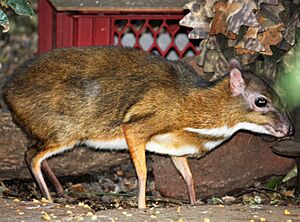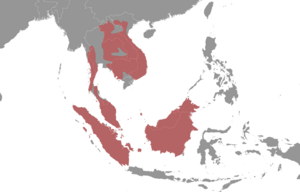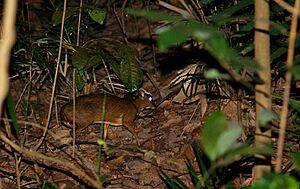Lesser mouse-deer facts for kids
Quick facts for kids Lesser mouse-deer |
|
|---|---|
 |
|
| A lesser mouse-deer in a German zoo | |
| Conservation status | |
| Scientific classification | |
| Genus: |
Tragulus
|
| Species: |
kanchil
|
 |
|
The lesser mouse-deer, also known as the lesser Malay chevrotain or kanchil, is a tiny hoofed mammal. It belongs to a group of animals called chevrotains. These small creatures are known for their deer-like appearance, even though they are not true deer.
Where They Live
The lesser mouse-deer lives in many parts of Southeast Asia. You can find them in countries like:
- Brunei
- Cambodia
- China (southern Yunnan province)
- Indonesia (on islands like Kalimantan and Sumatra)
- Laos
- Malaysia (including Peninsular Malaysia and Sarawak)
- Myanmar
- Singapore
- Thailand
- Vietnam
They live in forests and jungles across these regions.
What They Look Like and Their Habits
The lesser mouse-deer is one of the smallest hoofed mammals on Earth! It can be as small as 45 centimeters (about 18 inches) long and weigh only 2 kilograms (about 4.4 pounds). It is related to the even smaller Java mouse-deer.
For a long time, people thought these animals were active only at night (nocturnal). However, scientists have found that they are actually active during the day! Female mouse-deer can have babies throughout the year. But many births happen in May, November, or December.
Mouse-Deer in Stories
In Indonesian and Malaysian folk tales, the mouse-deer is a famous character named Sang Kancil. He is known for being very clever and tricky. Sang Kancil is a lot like the character Br'er Rabbit from the American "Uncle Remus" stories. Both characters often trick their enemies by pretending to be dead or by losing a race on purpose.
The mouse-deer also appears in the novel King Rat. In this story, a character sells rat meat to officers in a prison camp. He tells them it is mouse-deer meat to trick them into eating it.



